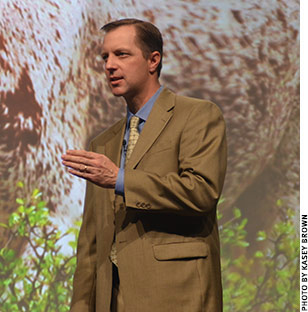Global Beef Market Outlook
Supply will catch up with demand, but will take time.
SAN ANTONIO, Texas (Feb. 5, 2015) — There is a simple equation that results in record-high beef prices: tight global supply plus burgeoning demand equals record prices. Brett Stuart, global market specialist consultant to CattleFax, explained that global beef demand is far outstripping supply. He addressed cattlemen at the CattleFax Oulook Seminar Feb. 5 during the 2015 Cattle Industry Convention & NCBA Trade Show in San Antonio, Texas.
Will supply catch up with demand? Yes, he answered, but it will take three to five years.

Global beef production has been stagnant for the past eight years, Brett Stuart said, adding that he does not expect global beef supply to increase significantly until 2017.
Global beef production has been stagnant for the past eight years, Stuart said, adding that he does not expect global beef supply to increase significantly until 2017.
The United States retains a strong global demand for beef exports, however a tight supply will lead to decreased exports in 2015, Stuart predicted. The rising U.S. dollar has added a 10%-15% cost to U.S. beef products in key markets. However, global demand has stayed in tact. Yet if 15% is added to the dollar in six months, there will be push back.
The world’s top two beef exporters, Brazil and India, are in expansion modes right now. Brazil’s export forecast is up 10%, and India’s forecast is up 5%. However, neither of these two countries are major competitors with the United States. They offer a different product to different markets.
Australia is a competitor in several markets, but the Australian herd has decreased 4% in 2015 after stronger export demand and drought caused higher slaughter rates in 2014. That said, Stuart predicted that Australian beef exports will be 7% lower in 2015. He added that less Australian beef on the market means that U.S. grinding prices may have to move higher for U.S. importers to keep pace with 2014 levels.
The United States imports Australian beef, and he said prices will remain high. U.S. imports are forecast to remain level, and exports are forecast to decrease 2%.
Global poultry demand is also outstripping supply due to the highly pathogenic avian influenza. This avian flu has been found everywhere globally except South America, which has affected trade flows. Stuart said the United States will have trade issues if the flu spreads from the northwest to the southeast, where poultry production is more concentrated.
Tight supply is a factor for the global pork industry, too. The U.S. pork industry is recovering from the porcine epidemic diarrhea virus (PEDv), and Stuart admitted that it would be a global game changer if PEDv were to hit Eastern Europe and Russia. Fortunately, it has not.
Additionally, Chinese data suggest there will be a pork gap in 2015. Half of the world’s pigs live in China. In 2014, China pork producers liquidated 6 million sows due to two years of high corn prices — up to $9.50 per bushel. Stuart said it would wreak havoc on our markets in they run out.
He also said that the falling U.S. hog market — due to the West Coast port backlog, cheap European Union pork in key markets, and the rising dollar — is the anchor on the neck of the beef industry.
He concluded with a watchlist of issues that can affect global markets, including U.S. West Coast port disruptions, Hong Kong trade disruptions, the rising U.S. dollar, China sow liquidation, China beef access, mandatory country-of-origin labeling, and the Trans-Pacific Partnership .
Editor’s Note: The articles used within this site represent a mixture of copyrights. This article was written by staff or under contract for the Angus Journal. If you would like to reprint or repost an article, you must first request permission of the Angus Journal by contacting the editor at 816-383-5200; 3201 Frederick Ave., Saint Joseph, MO 64506. The Angus Journal claims copyright to this website as presented. We welcome educational venues and cattlemen to link to this site as a service to their audience.

